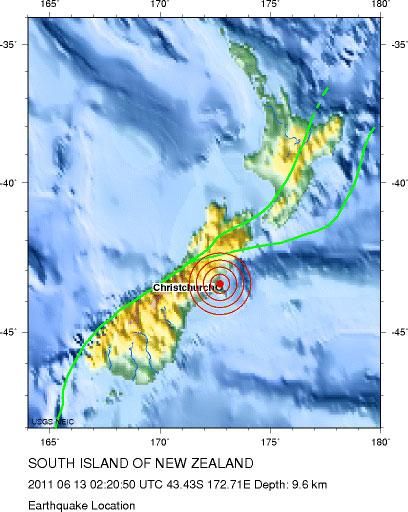
Quakes Strike New Zealand City Again

A magnitude 6.0 earthquake has struck the city of Christchurch, New Zealand, just months after a larger earthquake wreaked havoc on the city.
The 6.0 quake was the strongest of several temblors that rattled the city Monday local time (Sunday in the United States). Four of the quakes were above magnitude 4.3, according to Reuters.
Only minor injuries and damage to buildings already weakened by the magnitude 6.3 earthquake that shook the city on Feb. 22. That earthquake, which killed a reported 181 people, was considered an aftershock of a magnitude 7.0 earthquake that struck outside the city in September.
The 6.3 quake was deadlier because "its location is essentially under Christchurch," Don Blakeman, a geophysicist with the USGS in Golden, Colo., told OurAmazingPlanet at the time.
That quake also struck in the worst possible place and time, near the middle of the city during business hours 12:51 p.m. local time (6:51 p.m. EST Feb. 21). The recent 6.0 quake struck at 2:20 p.m. local time (10:20 p.m. ET).
New Zealand is a nation of islands along the volatile Pacific Ring of Fire a narrow zone around the Pacific Ocean where a large chunk of Earth's earthquakes and volcanic eruptions occur. Roughly 90 percent of all the world's earthquakes, and 80 percent of the largest ones, strike along the Ring of Fire.
Every year New Zealand has about 100 to 150 quakes large enough to be felt, according to GNS Science, a New Zealand earth science research firm. Since records began being kept in the 1840s, New Zealand has averaged several magnitude 6 earthquakes every year, one magnitude 7 every 10 years, and a magnitude 8 every century, GNS said.
Sign up for the Live Science daily newsletter now
Get the world’s most fascinating discoveries delivered straight to your inbox.
New Zealand's largest known earthquake was a magnitude 8.2 that hit Wairarapa in 1855. New Zealand's deadliest quake was a magnitude 7.8 in the North Island's Hawke Bay that killed about 250 people in 1931.











